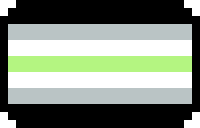
CLICK HERE FOR THE MOST RECENT VERSION OF THIS PAGE
Agender

Table of Contents

Introduction
There are numerous nonbinary gender identities that people can identify as. Agender is a somewhat common term that people identify as. The term has existed since at least the mid-90s. Not everyone who identifies as agender will use the same pronouns as each other, or display the same gender presentation.
May 19th is agender pride day.

General Information
To be agender is to not identify with experiencing or having a gender. Some people who are agender may describe their gender as the following; gender neutral, genderless, having an unknown or undidentifiable gender, neutrois, not knowing or caring about their gender, lacking gender, having a null gender, identifying as more of an individual than any gender at all, without gender, not aligning with any other gender, genderfree, having a gender that is outside of the gender binary, genderblank, or simply having no other words to accurately describe their gender identity.
For some people, to label themselves as having a gender is to label themself as having more of a gender than they even do, for identifying as agender can still constitute being labeled as having a gender. For others, the label of agender is simply a declaration of not having a gender. The presentation of agendered people can vary, though most prefer to dress in a way that is not gendered. Some agender people seek out nullification surgeries.

History
The term "agender" is derived from the prefix "a" meaning "not" and word "gender." Together, this word means "not gender" or "not having a gender." While the usage of the term "agender' has been documented for several decades, the original coining of the term is unknown.
The first known usage of the word agender on the internet to refer to a person was in June of 2005 on an internet forum known as UseNet in a chat room discussion entitled "alt.politics.democrats" by user man_in_black529 who wrote "But despite this near-universality of gender, cultures can have transgender, agender, and hypergender individuals."
The first known usage of the word "agender" on the internet was in the year 2000 on the afformentioned internet forum known as UseNet in a chat room discussion entitled "alt.messianic" when a user posted “God is amorphous, agender, [...] so image can’t be a physical or gender or sexual thing.”
The first known usage of a hyphenated version of the word (a-gender) was in 1996 in the British newspaper "The Independent" where it was written as "How the drinks industry labels young drinkers: Cyber Gen, the wired generation..A-gender, Tank girl meets new man—androgynous and proud."

Agender Flag
The agender pride flag was designed in the year 2014 by Salem X and shared on the website known as tumblr. The flag features seven horizontal stripes, and the colors are symmetrical.

The two black stripes in the agender flag represent a lack of or absence of gender. The black stripes also represent the resilience and strength of the agender community.
The two gray stripes in the agender flag represent semi-genderless identities and the fluidity of those who identify as both partially gendered & gender neutral.
The two white stripes in the agender flag represent a lack of gender, gender neutrality, and the experience of being neither female nor male.
The green stripe at the center of the agender flag represents nonbinary genders. The green stripe also represents the importance of acceptance and inclusivity within the LGBTQIA+ community.

External Links
The following links have been provided for entertainment, education, or further reading to encourage seeking out additional information. None of these links are sponsored, nor endorsed. The inclusion of an article/video/etc is not complete approval for its contents. The thoughts/views/opinions/etc of everything included below do not inherently represent those of The Transgender Dictionary.

Flag Resources
- Flag Color Codes - Agender (https://www.flagcolorcodes.com/agender) - the hex codes for the colors of the agender flag
- Flags For Good: Michael Green: 05/17/2023: Agender Pride Flag - Meaning and History (https://flagsforgood.com/blogs/news/agender-pride-flag-meaning-and-history) - explanation of agender meaning, flag, and history
- Good Good Good: Kamrin Baker: 01/04/2024: What Is the Agender Pride Flag & What Does It Mean? (https://www.goodgoodgood.co/articles/agender-pride-flag) - article regarding agender flag history, colors, and meaning
- Into More: Eloisa De Farias: The Agender Pride Flag (https://www.intomore.com/culture/identity/the-agender-pride-flag/) - article about agender pride flag as well as similar identity flags
- LGBTI News: Selin: 12/23/2024: Agender Pride Flag (https://news.lgbti.org/agender-pride-flag/) - short article about agender pride flag and color meaning
- Queer in the World: Cecilia Miller: 10/14/2023: What Exactly Is The Agender Pride Flag, And What Does It Mean? (https://queerintheworld.com/agender-pride-flag/") - article regarding flag meaning
- Salford Journal: Runa Khan: 10/09/2024: The Agender Flag: A Symbol of Identity and Inclusivity (https://salfordjournal.co.uk/agender-flag/) - article regarding agender history, meaning, flag, allyship, flag creator, etc
- Sexual Diversity: 12/17/2022: Agender Pride Flag (https://www.sexualdiversity.org/edu/flags/1089.php) - article regarding flag colors, meaning, history
- Tumblr: transrants: 01/04/2019: my name is salem and i created the agender flag. (https://www.tumblr.com/the-transgenda-agenda/781804775411007488/interview-creator-of-the-agender-flag-majestic) - introduction of most popular agender flag
- Wikipedia - Agender Pride Flag (https://en.wikipedia.org/wiki/File:Agender_pride_flag.svg) - image of agender pride flag

Additional Resources
- Dictionary: Agender (https://www.dictionary.com/browse/agender) - definition for agender
- Cambridge Dictionary: Agender - definition for agender
- Gender - Fandom - Gender Wiki - Agender (https://gender.fandom.com/wiki/Agender) - crowdmade wiki with history, meaning, alternate flags, and comments
- Healthline: Sian Ferguson & Janet Brito, Ph.D., LCSW, CST-S: 01/20/2021: What Does It Mean to Be Agender? (https://www.healthline.com/health/agender) - article about agender, similar identities, how to figure out if you are agender, meaning, etc
- Merriam Webster: Agender (https://www.merriam-webster.com/dictionary/agender) - definition for agender
- New - LGBTQIA - Wiki - Agender (https://new.lgbtqia.wiki/wiki/Agender) - wiki regarding agender meaning, history, dysphoria, flag, alternate flags, symbols, etc
- Nonbinary Wiki - Agender (https://nonbinary.wiki/wiki/Agender) - wiki regarding agender history, meaning, similar terms, research, and notable real people & fictional characters who are agender
- Oxford English Dictionary: Agender (https://www.oed.com/dictionary/agender_adj) - definition for agender
- Queer Books for Teens - Agender (https://queerbooksforteens.com/find-books/?fwp_gender=agender) - list of books with agender characters
- Queer in the World: Cecilia Miller: 10/14/2023: What Does Agender Mean? + Other Agender Information To Help You Be A Better Ally! (https://queerintheworld.com/what-does-agender-mean/) - article about agender meaning, experience, flag, pride day, allyship, etc
- Reddit - r/agender - subreddit for agender
- Them: 08/07/2018: Inqueery: What Does It Mean to Be Agender? (https://www.them.us/story/inqueery-agender) - transcript of video discussing agender meaning and history (also has video available)
- Trans Language Primer - Agender (https://translanguageprimer.com/agender/) - blurb regarding agender meaning and flag
- Wikionary: Agender (https://en.wiktionary.org/wiki/agender) - wiki for agender

